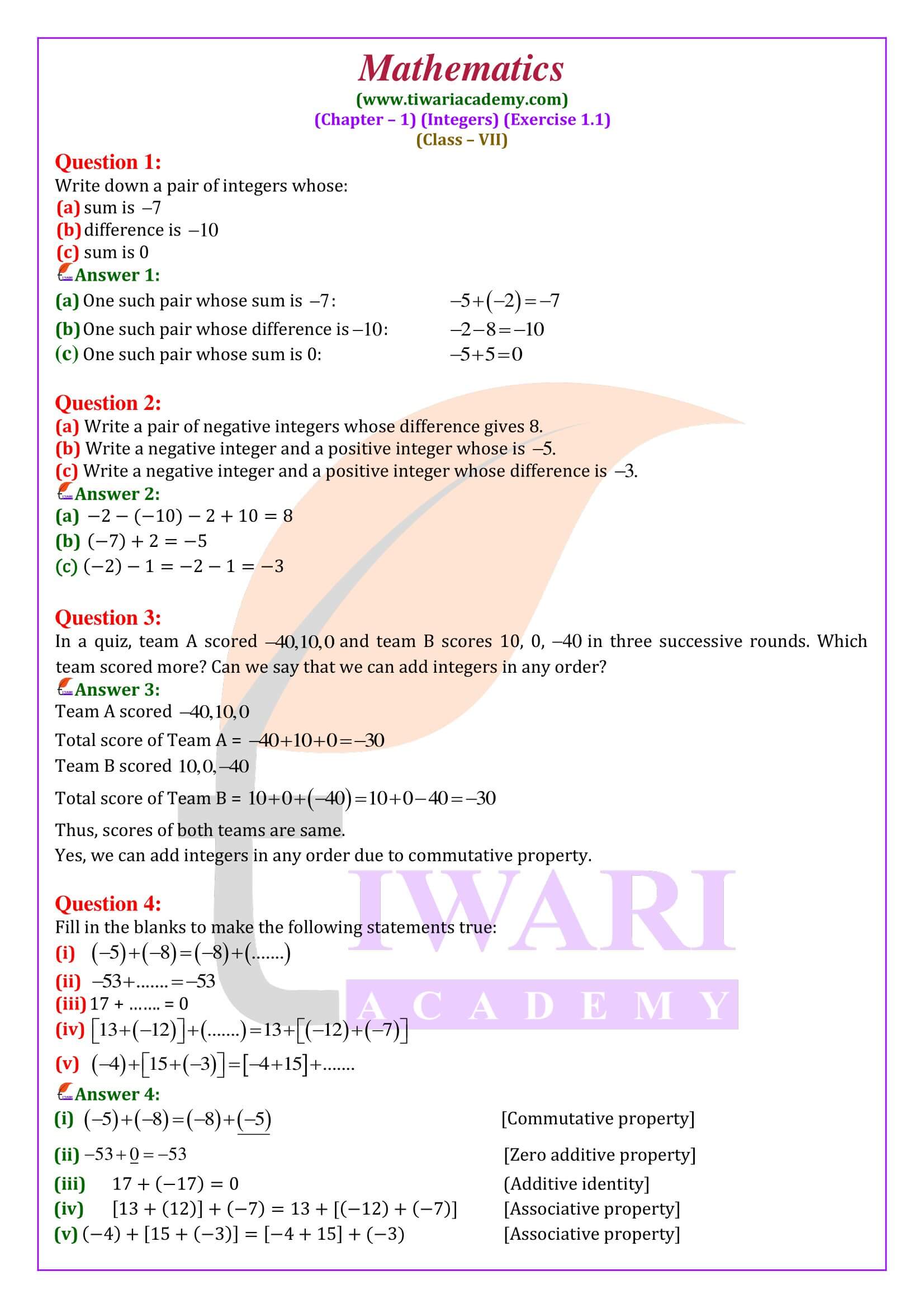NCERT Solutions for Class 7 Maths Chapter 1 Exercise 1.1 Integers modified and updated for new Session 2025-26 in Hindi and English Medium. All the question-answers and solutions are revised on the basis of new syllabus and latest NCERT textbooks issued for curriculum 2025-26.
NCERT Class 7 Maths Exercise 1.1 Solution in Hindi and English Medium
| Class: 7 | Mathematics |
| Chapter: 1 | Exercise: 1.1 |
| Topic: | Integers |
| Content Type: | PDF, Text, Images and Videos Solution |
| Session: | CBSE 2025-26 |
| Medium: | Hindi and English Medium |
Class 7 Maths Chapter 1 Exercise 1.1 Solution
All the question answers with solutions are done according to latest NCERT Books for 2025-26. In class 7 math exercise 1.1, we will learn to add positive and negative integers and work with practical problems occurring in daily life. All the questions are easy to solve in ex. 1.1 of class 7 mathematics.
Subtraction of Integers
For any integers a and b, we define:
(i) a – b = a + (additive inverse of b) = a + (- b).
(ii) a – (- b) = a + [additive inverse of (- b)] = a + b.
Properties of Subtraction of Integers
I. Closure Property for Subtraction:
If a and b are any two integers, then (a – b) is always an integer.
Example: (i) 2 – 5 = 2 + (- 5) = – 3, which is an integer.
(ii) – 2 – (- 6) = – 2 + 6 = 4, which is an integer.
II. Subtraction of Integers is not Commutative:
Examples:
(i) Consider the integers 3 and 5.
We have: (3 – 5) = 3 + (- 5) = – 2 and (5 – 3) = 5 + (- 3) = 2.
So, (3 – 5) ≠ (5 – 3).
(ii) Consider the integers (- 4) and 2.
We have: (- 4) – 2 = (- 4) + (- 2) = – 6 and 2 – (- 4)
= (2 + 4) = 6.
So, (- 4) – 2 ≠ 2 – (- 4).
Class 7 Maths Exercise 1.1 Important Questions
Subtract: (i) 9 from 4 (ii) – 8 from 5 (iii) 7 from (- 6) (iv) – 9 from – 5
We have:
(i) 4 – 9 = 4 + (- 9) = – 5
(ii) 5 – (- 8) = 5 + 8 = 13
(iii) (- 6) – 7 = (- 6) + (- 7) = – 13
(iv) – 5 – (- 9) = (- 5) + 9 = 4
What are the rules for subtraction of integers?
Steps on How to Subtract Integers:
(i) First, keep the first number (known as the minuend).
(ii) Second, change the operation from subtraction to addition.
(iii) Third, get the opposite sign of the second number (known as the subtrahend)
(iv) Finally, proceed with the regular addition of integers.
Why subtraction of integers is not associative?
Contrary to addition, subtraction doesn’t have the associative property. If we subtract the first two numbers, 10 minus 5, it gives us 5. … Changing the way of associating the numbers in subtraction changes the answer. Thus, subtraction doesn’t have the associative property.
Consider the integers (- 5) and (- 2), use associative law?
Consider the integers (- 5) and (- 2).
Then, (- 5) – (- 2) = (- 5) + 2 = – 3.
Clearly, – 3 > – 5 but – 3 is not greater than – 2.
Why is subtraction not commutative?
Subtraction is not commutative because changing the order of the numbers changes the answer. Addition is commutative, which means that the order in which we add numbers does not matter. Because both additions have a 3 and a 5 added together, the answer to both sums is the same.
III. Subtraction of Integers is Not Associative
Example:
Consider the integers 3, (- 4) and (- 5).
We have: {3 – (- 4)} – (- 5)
= (3 + 4) – (- 5) = 7 – (- 5) = (7 + 5) = 12.
And, 3 – {(- 4) – (- 5)} = 3 – {(- 4) + 5} = (3 – 1) = 2.
So, {3 – (- 4)} – (- 5) ≠ 3 – {(- 4) – (- 5)}.
Are there any examples in exercise 1.1 of Maths class 7th?
Yes, there is only one example (example 1) in exercise 1.1 of grade 7th Maths. This example is very simple to solve and understand. Students can easily do this example. Example 1 and Questions 1, 2 of exercise 1.1 of 7th standard Maths are of the same kind.
Which topics are more important to teach in exercise 1.1 of Maths class 7th?
The topics that teachers teach in exercise 1.1 of Maths class 7th are:
Properties of Addition and Subtraction of Integers.
a. Closure under Addition
b. Closure under Subtraction
c. Commutative Property
d. Associative Property
e. Additive Identity
How many days are required to complete exercise 1.1 of class 7th Maths?
If students give 1 hour per day to exercise 1.1 of class 7th Maths then, 2 days are sufficient to complete exercise 1.1 of class 7th Maths because exercise 1.1 has only one example (example 1) and four questions. This time can vary because different students have different working speeds, efficiency, capability, etc.
Which questions of exercise 1.1 of class 7th Maths are considered as the most important questions?
Exercise 1.1 of class 7th Maths has 1 example (example 1) and four questions. All questions and example of exercise 1.1 of 7th standard Maths are important. But, the most important problems of this exercise are questions 2 (a), 3, 4 (i) (ii) (iii).





